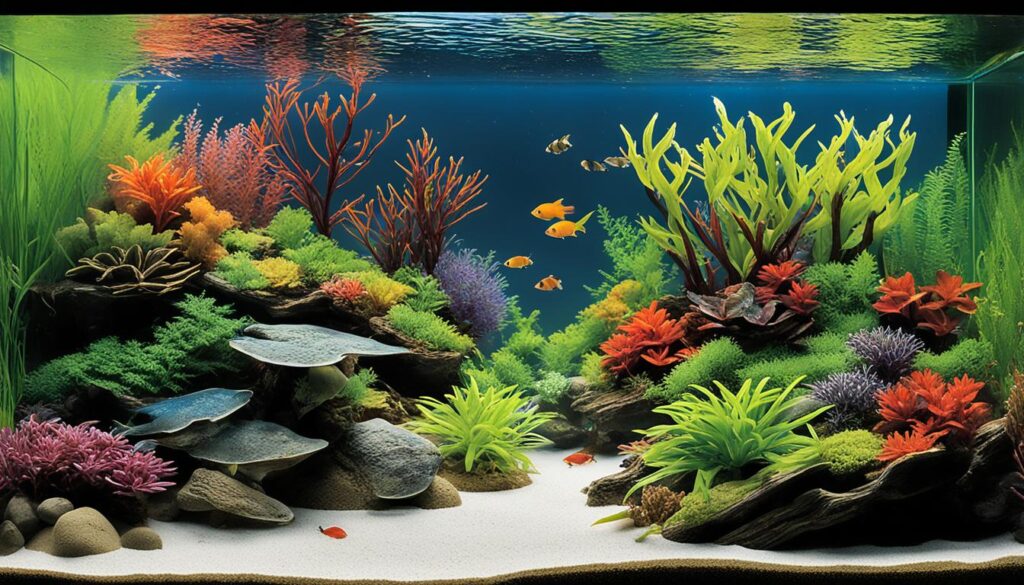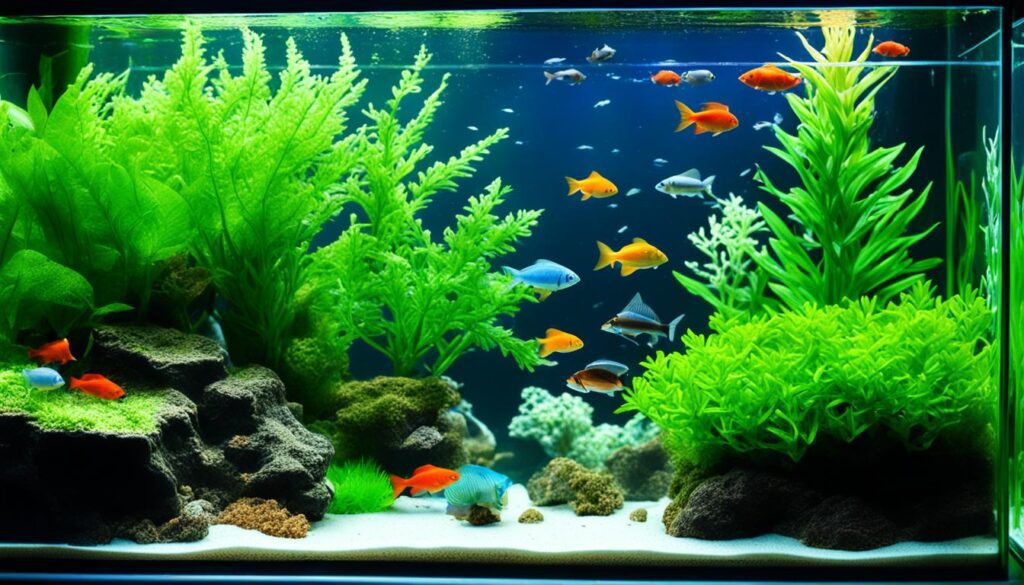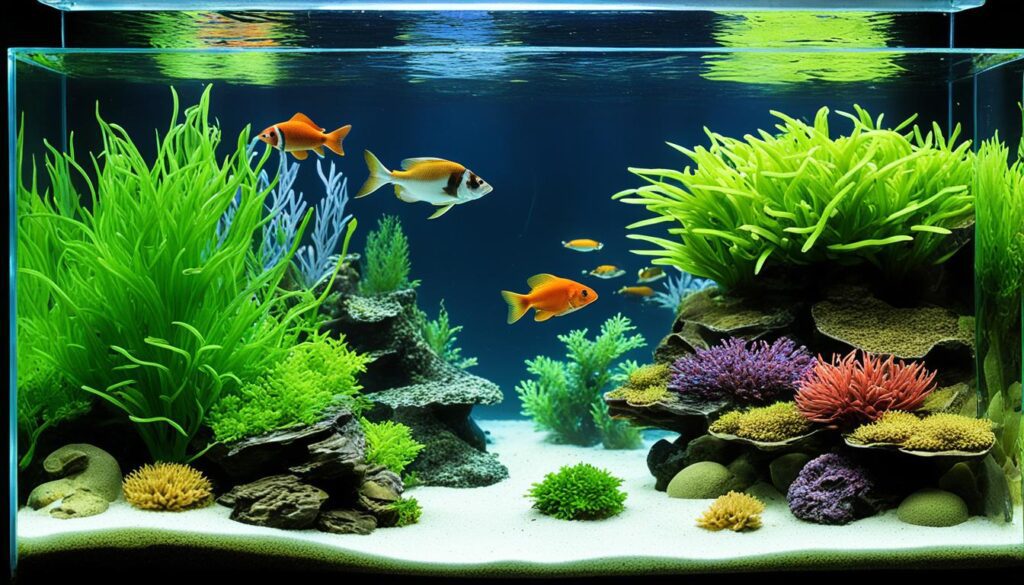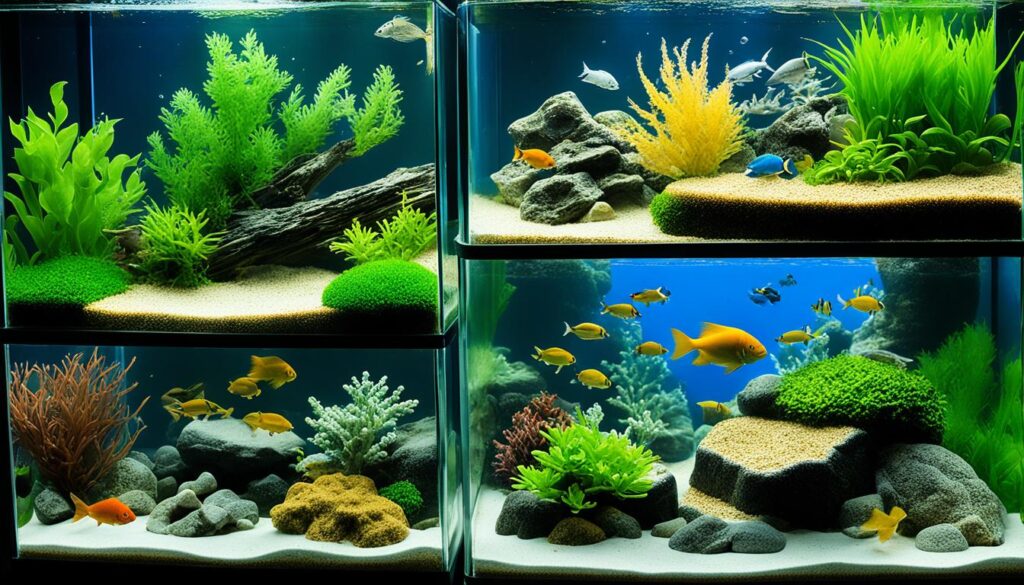Aquatic ecosystem health depends on every choice we make. I have focused on the aquarium substrate. It is not just for looks. It greatly affects substrate influence on water parameters, like pH balance and nutrient levels.
Choosing the right substrate, like gravel or sand, is important. It affects how our aquariums look and work. Studies on gilthead seabreams show the right substrate can improve growth and behavior. Goldfish also react differently to various substrates. This proves the strong link between aquarium substrate impact and aquatic life’s health.
Choosing a substrate is about more than beauty. It affects water chemistry and life in the tank. Some substrates are good for plants but can change water quality over time. My experience shows that substrate choices affect the behavior, health, and color of aquatic creatures. It is a key part of aquatic ecosystem health.
Introduction to Aquarium Substrates and Their Role in Ecosystems

Choosing the right substrate is key when starting a new aquarium. It’s not just about making your tank look good. More importantly, it affects the health of the aquatic world inside. Substrates are the foundation that impacts water chemistry, plant and fish health, and biological filtering.
Substrates come in two types: active and inert. Each suits different aquarium needs. Active substrates like ADA Aqua Soil and Seachem Flourite help plants grow. They lower the pH, which is good for certain fish. Inert substrates, such as gravel and sand, keep the water chemistry stable. They’re great for fish that prefer neutral to alkaline water.
Substrate Type |
Impact on pH |
Key Benefits |
|---|---|---|
Active Substrates (e.g., ADA Aqua Soil) |
Acidic |
Enriches with nutrients, ideal for plant growth |
Inert Substrates (e.g., Gravel, Sand) |
Neutral |
Maintains stable pH, easy maintenance |
Substrates do more than look nice. They help with the nitrogen cycle. This cycle breaks down fish waste. Beneficial bacteria live in substrates like sand. They turn the waste into something plants can use. This is vital for a healthy aquarium.
Layers of different substrates can benefit plants. For instance, a layer of aqua soil under gravel helps roots grow. It also keeps the top stable. This is good for the tank’s look and health.
In summary, substrates play a big role in aquariums. They support life and keep the environment healthy. Whether you choose a type full of nutrients or one that’s inert, make sure it fits your tank’s needs. This will help create a thriving underwater world.
The Science Behind substrate choice affet water quality

Understanding aquarium water quality starts with substrate science. The type of substrate you choose can have a big impact on the water’s chemistry and the health of the aquarium. Different materials, like sand or pebbles, change the water in unique ways. They affect things like pH levels and how many nutrients are available.
Choosing the right substrate is key for a balanced aquarium. It’s not just for looks; it’s about creating a healthy home for fish and plants. The best substrates help control water hardness and keep pH levels steady. Some can even soak up extra nutrients and harmful chemicals, keeping the water clean.
A study you can see on this page looks at how different substrates affect diatom communities. This research shows how some substrates can change water chemistry to benefit certain fish and plants.
The size of the substrate particles also matters. It can affect how water moves and how well plants root. Fine substrates are good for roots but might slow water flow and hold too many nutrients. This could make the water quality worse over time if it’s not managed right.
It’s important for aquarium owners and ecologists to get these details right. Balancing the physical and chemical needs of an aquarium helps keep everything healthy and stable. Making smart choices about substrate can help both new and experienced aquarists.
The field of substrate science is growing, offering new insights into how substrates interact with water and aquatic life. It’s about more than just making a nice-looking tank. The right substrate creates a balanced ecosystem, supporting clear water and lively aquatic plants and animals.
Comparing Inert Substrates to Nutrient-Rich Options

Choosing the right substrate is key for a healthy aquarium. Nutrient-rich options support plant growth by giving essential nutrients. These nutrients lead to strong plants and roots.
Inert substrates like CaribSea Eco-Complete or Seachem Flourite, don’t directly feed plants. But, they’re loved for keeping water clear and lasting a long time. They help keep the tank clean and don’t need to be replaced often.
Impact on Nutrient Levels and Plant Health
Nutrient-rich substrates boost the health of root-feeding plants. ADA Aqua Soil, for example, releases nutrients slowly. This keeps plants vibrant but needs refreshing every couple of years.
Substrate Longevity and Water Clarity Concerns
Inert substrates are great for clear water and stable chemistry. They don’t muddy the water as they don’t break down. This means a clearer and healthier tank.
Preserving Water Chemistry: pH and Hardness Influences
The right substrate can affect your tank’s pH and water hardness. Nutrient-rich types can lower pH, which is good for some fish and plants. But inert substrates offer predictable water chemistry, helping you keep desired levels.
Substrate Type |
Benefits |
Longevity |
Effect on Water Chemistry |
|---|---|---|---|
Nutrient-rich (e.g., ADA Aqua Soil) |
Supports robust plant growth, reduces need for additional fertilizers |
1-2 years before replenishment needed |
Lowers pH, softens water |
Inert (e.g., Seachem Flourite) |
Maintains water clarity, high CEC aids nutrient availability |
Does not decompose, long-lasting |
Minimal impact, allows stable pH and hardness |
Knowing about substrates helps aquarists make smart choices. This ensures their aquariums and all living in them flourish.
Substrate Granularity and Its Effect on Water Movement

It’s key to understand the role of granular substrates in an aquarium for good water quality and strong aquarium plant rooting. The size of the particles in the substrate greatly impacts water flow impact. It affects the health of the plants and the tank’s ecosystem.
Fine substrates like sand can become packed down over time. This makes water move slower, leading to low oxygen areas that hurt plant roots and fish. On the other hand, larger particles in substrates, like gravel, boost water movement. This avoids harmful packing of the substrate and helps move nutrients to plants, aiding their growth and stability.
- Increased Water Circulation: Larger granular substrates improve water flow. This is crucial for spreading nutrients and oxygen all through the tank.
- Enhanced Root Penetration: Coarse particles leave space for roots to get through and hold on, which is important for strong aquarium plant rooting.
- Reduced Compaction: Keeps the substrate from getting too tight, which stops low oxygen zones that could damage plants and fish.
Choosing the right substrate size is vital for a well-running aquarium. It not just adds beauty but also supports the living conditions, affecting water movement and plant health.
Substrate Type |
Particle Size |
Impact on Water Flow |
Impact on Rooting |
|---|---|---|---|
Fine Sand |
0.1-0.5 mm |
Poor |
Low |
Coarse Gravel |
5-20 mm |
Excellent |
High |
Medium Gravel |
1-5 mm |
Good |
Moderate |
Picking the right granular substrates impacts your aquarium’s water flow impact, aiding in strong aquarium plant rooting. This makes sure your aquatic world flourishes. Keep these pointers in mind for a healthier, more beautiful aquarium.
Addressing Substrate-Associated Diseases and Health Impacts

For those who love keeping their aquariums spotless, knowing the importance of substrate selection is key. The right substrate helps prevent diseases and keeps the water healthy. It’s amazing how choosing wisely can fight diseases linked to substrates and stop harmful germs from growing in them.
Preventing Disease through Substrate Selection
Fish and other water creatures do best in settings that feel like home. For instance, sand helps fight skin diseases in certain fish, showing its role in disease prevention. These natural environments can boost the immune systems of aquatic life, reducing risks of disease from substrates.
- Sand Substrate: Offers fine granulation which can be beneficial for certain species in mimicking their natural aquatic landscapes.
- Gravel Substrate: With larger particles, it’s less likely to harbor harmful microbes that can contribute to pathogen growth.
- Composite Substrates: May include pebbles or pre-treated options tailored to reduce microbial growth and enhance biosecurity.
Understanding the Connection between Substrates and Pathogen Growth
Studies have shown how different substrates can affect the spread of harmful bacteria like Pseudomonas spp. The material and cleanliness of the substrate are key to controlling microbes in an aquarium. If substrates are dirty or not well kept, they can become breeding grounds for dangerous microorganisms, raising health concerns.
Key Insights:
- The use of clean and well-maintained natural substrates like sand can significantly decrease the risk of pathogenic outbreaks.
- Regular monitoring and maintenance of water quality parameters such as pH, temperature, and dissolved oxygen are essential for inhibiting pathogen growth in substrates.
- Seasonal assessments can help understand fluctuations in pathogen activity, aiding in strategic proactive substrate management.
Making smart substrate selection choices and keeping up with routine care goes beyond just making your tank look good. It’s crucial for a healthy, disease-free environment. This strategy not only encourages a vibrant aquatic life but also maintains strict aquarium biosecurity. It keeps your water pets safe from diseases linked to substrates.
How Substrate Choices Shape the Behavior and Welfare of Aquatic Life

The choice of substrate in water habitats is more than just for looks. It plays a major role in affecting aquatic life behavior, animal welfare, and substrate environmental enrichment. In aquariums, the right substrate can greatly influence the well-being of fish and other species. It shapes their behavior and how they interact with each other.
Zebrafish, for instance, prefer substrates that remind them of home. This preference helps them in their search for food and encourages them to behave as they would in the wild. Such substrates not only provide a physical space but also promote natural social interactions.
- Studies have shown that zebrafish display enhanced learning capabilities when their habitats include substrates that facilitate complex sensory experiences.
- Such enriched environments can reduce stress, improve cognitive function, and promote healthier social interactions.
- Substrate diversity can also support diverse microbial communities that are beneficial for the aquatic environment, further influencing fish behavior and health positively.
Diverse substrates lead to varied foraging behaviors and social interactions in zebrafish. This suggests that having different types of substrates is crucial. It helps create environments that are closer to their natural settings and improves their well-being.
Looking into substrate environmental enrichment helps us understand how substrates can be cognitive tools and safe spaces for fish. They provide comfort and safety. This directly affects the survival and welfare of aquatic species.
Applying research to make informed substrate choices is key to improving animal welfare and natural behavior in water life. This approach benefits the creatures living in these habitats. It also makes observing and learning from them more enriching.
Analyzing the Interplay between Substrate Type and Aquatic Microbiomes
On my path to understanding aquarium life, I’ve been fascinated by how substrate types interact with aquatic microbiomes. These microbiomes are essential for a healthy aquatic system. The material at the bottom of an aquarium affects important bacteria. It either helps them thrive or holds them back. Let’s explore how the choice of substrate impacts our aquariums’ ecosystems.
Recent research highlights the complex relationships within these tiny communities. A study found 2,585 different kinds of organisms in these ecosystems. The variety in these tiny life forms is huge. Although environmental factors usually matter more, the type and texture of the substrate have big effects. For example, smooth substrates like glass favor certain species. Meanwhile, rougher materials support a wider range of organisms.
Delving into these interactions is crucial for maintaining healthy aquariums. Choosing the right substrate can encourage beneficial bacteria. These bacteria break down waste and help keep the water quality high. They also protect our fish from diseases. Surprisingly, the bacteria in water share 73% of their genes with those in the human gut. For those of us who keep aquariums, understanding these microbiomes is vital. They impact not just our tanks, but also the larger environmental picture.








